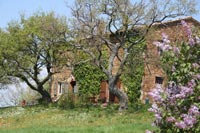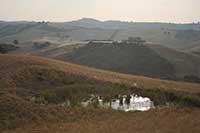L’Orto de’ Pecci, a piece of countryside just a few hundred metres from Piazza del Campo, is a green “treasure” with an ancient, fascinating history that many of Siena’s residents know nothing about: a “piece of city” which lived in the 14thcentury and was killed by the plague, crossed by condemned prisoners who passed under Porta Giustizia on their way to be executed.
|
The Orto Botanico dell'Università di Siena is located at Via P. A. Mattioli, 4, Siena, and open daily without charge.
The garden's history reaches back to 1588 when the university began to raise medicinal herbs. In 1756 the field of herbal studies was supplanted by natural history, and starting in 1759, under the direction of Giuseppe Baldassarri, the garden began to collect uncommon plants. In 1784 the Grand Duke of Tuscany Peter Leopold began university reform, and in a short time the garden's collection grew to contain more than a thousand new plants, many from abroad. Its first published record (the Seminum Index Siena) listed some 900 species, including several hundred from outside Italy. In 1856 the garden moved to its present location, the botany institute constructed 1910-1912, and in the 1960s the garden's area was doubled.
Today the garden is located inside Siena's city walls, covering one hillside of the valley S. Agostino. Its central collection is arranged in systematic order within brick-bordered, rectangular flower beds, along with old specimens of exotic and local plants. A farm area grows fruit, olive trees and vines of the main Chianti grapes. The garden also contains three greenhouses enclosing a total of about 500 m², namely, a tropical greenhouse, tepidarium that houses exotic species in winter as well as a succulent collection (120 m²) organized by country of origin, and an orangerie containing carnivorous plants and the principal citrus varieties grown in Europe.[1]
|





